Kraals
Kraals are a widely used method of protecting livestock from predators and are used across much of Africa. A Kraal is an enclosure which is used to keep livestock safe. Typically livestock is let out to graze during the day and then returned to the kraal for the night. The kraal can be constructed in a number of ways. One of the most common is a thorn bush kraal where thorny branches are used to create a wall which keeps predators out. Other construction methods include the use of wicker (woven poles), wire fencing, and wood or stone walls.
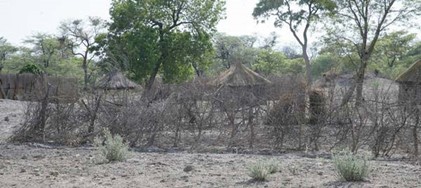
The kraal should have high enough sides to stop a predator from jumping over them and into the kraal. It also needs to be strong enough to keep the livestock inside. If cattle smell a lion outside the kraal then they can easily panic and stampede - and if the kraal isn't strong enough then they can break out of the kraal to where the lion is waiting.
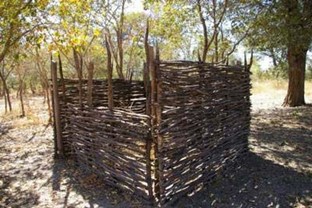
Research has shown that a kraal is most effective if its sides are thick enough or constructed in such a way that the predators cannot see through the walls of the kraal. When making a kraal out of wire mesh, cloth can be used to screen off the lower metre or so of the fence to stop the predators from seeing through. With thorn bush kraals then making the thorn bush walls thicker helps restrict the view of the predators.
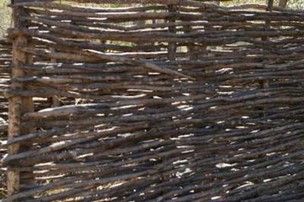
Another factor shown to be key to the success of a kraal is the number of gates in the walls. Ideally, there should just be a single gate.
The kraal should be sited near home so that if there is a disturbance at night, it will be heard and can be investigated immediately.
Moving livestock in and out of kraals can be seen as extra work for a farmer, but it has several benefits. Firstly the livestock is a lot safer if it is kept in a kraal at night (when predators such as Lions, Leopards and Hyenas are most active). Secondly by making sure the animals are counted in and out of the kraal then any missing animals can be quickly noticed and a search started for the missing animal. In contrast, farms, where the livestock is allowed to wander freely during the day and night, may not notice a missing animal for a much longer period. Also when moving the livestock in and out of the kraal the farmer is able to visually inspect the animals to identify any health problems and get sick or injured animals treated.
Kraals should also be used for calving animals. Keeping the calves and their mothers in a separate kraal for a few months after the birth of the calf gives the calf extra protection at the time when it is most vulnerable. This increases the chances of survival of the calf.
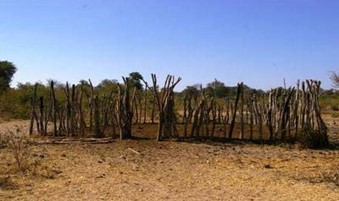
Fencing
Although it is not always practical, fencing grazing areas is one option to reduce or eliminate the threat from predators. By using wire fences plus electrified strands, it is possible to create a fence that will keep predators out. Fencing like this is expensive and is only generally used on larger commercial farms. Fencing has to allow places for animals such as warthogs to cross under the fence (usually using swing gates) as they would otherwise simply dig their way under the fence and leave an easy entry point for predators. Fences also need regular inspection and maintenance to ensure they are in good working order and there are no gaps for predators to enter.
Livestock Guarding Animals
One way to protect livestock is through the use of livestock guarding animals. Usually, these are dogs, but other animals such as donkeys are sometimes used. Guarding dogs protect the livestock by patrolling, scent marking and barking. They act as a deterrent to predators, particularly smaller predators such as caracal and cheetah, and will also chase off predators they see.
Example: Anatolian Shepherd dogs originate in the Anatolian plateau of Turkey. A plateau is a high, flat-topped mountain like Table Mountain. Summers are hot and dry, and winters are cold, but the Anatolian Shepherd Dogs live outside all year round. They were bred to guard sheep against predators, and are still used for this purpose.
The breed still exists in Central Turkey. From ancient days they have defended sheep from dangerous animals like bears, and wolves. They have also been used as fighting dogs in wars, and as hunting dogs.
They are large, imposing dogs, but not too heavy and fat to run fast! Agility is an important factor - not size alone. They must be able to stalk and chase a cheetah! Anatolian shepherds reach maturity at around 4 years of age.
In Namibia and South Africa, Anatolian shepherd dogs are being used on farms to protect flocks of sheep & goats from jackal, caracal, leopard and cheetah. God created all the animals for a purpose. We only live on earth temporarily. Let's not shoot all the wildlife, but use natural means like dogs to protect our assets! If we destroy all the small animals, the big predators will have no choice but to kill domestic animals for food.
The cheetah is the fastest land animal, able to accelerate from a standstill to 80 km/h in only three seconds; its top speed is 120 km/h. Their spines bunch up and release as they run, and their hips are flexible. At top speed, a cheetah does not touch the ground for eight meters. It is flying! The cheetah is the most endangered African cat. If these cats see a big dog, they are unlikely to approach! This is a much better way of controlling them than using cruel traps or poison.
Temperament
Anatolian Shepherds are alert, observant, and intelligent dogs. They are protective & possessive towards their families and territory. Care should be taken when friends visit! Careful bonding with the owner is necessary in puppyhood, in order to control a large dog when it is grown. This breed will not suit a meek, unassertive owner! The dog must not take charge of the owner!
Anatolians excel at guarding flocks, and if they are to be used for this, they should not be treated as pets but should live outside in all weathers with the flock, from a puppy. Thus the dog adopts the sheep as its family that it has to protect. One dog can protect a large flock of sheep.
If they are pets, then a big, secure yard is needed, and they should be taken for walks or runs every day.
Colour and Appearance
All colour patterns and markings are acceptable, but the usual colours are fawn with a black mask, pinto, white and brindle. The dogs have black lips, a black or brown nose and a muzzle. The almond-shaped brown eyes may be outlined with black or brown.
The head is big and broad. Ears normally hang down but stand up when listening. The neck is thick and powerful.
Anatolians have a solid robust neck, and their legs are long and straight with muscular paws. Their tail hangs low and has a slight curl at the bottom.
The back is short in proportion to the leg length.
Guard Donkeys
Guard donkeys, guard dogs, and guard llamas have all been used successfully to protect livestock. The choice depends on the livestock being protected, local terrain, hectare area, predator threats, budget, and personal preference. Whichever animal you choose, count on some training, extra feed, vet care, and housing expenses.
In some cases, you may need more than a single guard animal to protect livestock. Guard dogs can work together to patrol large areas and to fight off marauding packs of e.g. feral dogs and jackals that would overwhelm a single guard dog. Dogs and llamas sometimes can be trained to work together.
Guard animals can be effective, but in some situations, packs of predators will defeat the most diligent guard animals. If you are following an aggressive rotational grazing program, with livestock in several paddocks at the same time, you may need a guard animal for each paddock. Sometimes, even in a small field, a single guard animal can be overwhelmed.
How do guard donkeys protect a flock?
Donkeys have been used for centuries to protect sheep and other herding animals. Donkeys are extremely intelligent, with acute hearing (there is a reason for those big ears) and sight, and they are conservative by nature: they do not like change in their surroundings, and will drive off a predator or stray dog as much because it is an intruder as from any instinctive dislike of canines.
Donkeys are easy to care for — good grazing or hay and water is all they need — and delightful farm pets, if you accept that they are clever and rigid.
But not all donkeys are instinctive guards. Some will ignore an intruder, and there are stories of donkeys who run away from intruders, and donkeys who attack the livestock they are supposed to protect. If you're shopping for a guard donkey, stay away from intact (stallion) jacks in favour of a gelded jack or a jenny (female). Some breeders test and/or train donkeys for guard duty and will sell them with an agreement that will allow you to exchange the donkey for another if it doesn't work out as a guard. Remember too that a jenny with a foal may be too busy to watch livestock. Even a jenny in season is thinking more about jacks than about predators. Two donkeys together may spend their time playing donkey games instead of watching for predators.
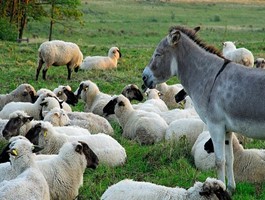
Guard Dogs
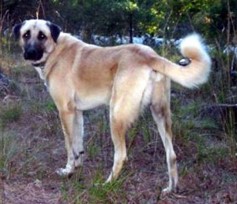
Guard dogs have been used to protect livestock from prehistoric times. The breeds used have ranged from mix-breed dogs to the traditional guard dog species: Akbash (Turkey), Maremma (Italy), Komondor and Kuvasz (Hungary), Liptok or Chuvatch (Czechoslovakia), Tatra or Podhalanski (Poland), Ovcharka (Caucasus), Shar Planinetz (Yugoslavia), and the Great Pyrenees (France). By tradition most guard breeds are light-coloured; the light coloured dogs are all-but-invisible to predators when they bed down with the livestock, and they are easily distinguished by a herdsman from darker-coloured predators.
Guard dogs have been bred and trained to enhance a trio of traits. To be effective, the guard dog must bond with the animals it is protecting, it must be courageous in the face of a predator, and it must accept the responsibility of its job. The dog lives day and night with the livestock it is protecting, and can be stand-offish toward people. Despite this essential independence, the owner needs to establish him or herself as the alpha figure in the dog's world.
Guard dogs have a repertoire of techniques to defend their livestock from predators. They are sensitive and primitive enough to be able to read the intent of a predator and to use the minimum measures necessary to defend the territory and flock. Attacking the predator is the last resort after other measures have failed. The first line of defence is a perimeter marking with faeces and urine that warns predators to Stay out!. If the markings do not deter a prowling predator, the guard dog will warn the predator with a staccato bark that announces Stay where you are; I can see/smell/hear you. If that fails, the bark escalates to a loud warning. If the predator persists in the face of the warnings, the guard dog will advance and charge at the predator, barking. The next step is a shoulder blow to the predator, saying, I can expose your jugular and kill you if you persist. The final defensive action could include killing the predator.
Guard dogs are bonded with the livestock they are supposed to protect by being introduced to stock as puppies, generally from 8 to 12 weeks. Once bonded, dogs accept the animals they are guarding as equals, or even as dominant. It takes some training and patience to get the bond right; puppies are playful, and will sometimes chase, bite, or even kill stock. Eventually, a good guard dog learns its role and will acknowledge an irate cow guarding her calf by moving away, lying down, or averting its eyes. Guard dogs live with the stock they guard, bedding down with the animals. Most guard dogs are fed with the stock. Sometimes a stock will eat the dog's food, although most dogs learn to protect their food.
Guard dogs are by disposition independent. Most will make their rounds at some time during the day, and spend a good deal of time at a favourite spot where they can watch the flock and the surroundings. It takes training and experience to teach a guard dog to accept pets and other adults, while not losing its instinctive wariness toward predators. When it spots an intruder, the dog will position itself between the intruder and the flock and make threatening gestures toward the intruder. If the intruder does not withdraw, the dog will attack. These are brave dogs, not afraid to attack predators much larger than themselves.
Some potential problems with guard dogs include wandering, chasing or playing with stock, and dogs that are territorial rather than bonded to the flock. The early training of the dog needs to take place in an enclosure so the dog learns not to wander. Some dogs later need a strand of electric fencing around the pasture to remind them where they should stay. Animals that chase or play with stock must be curbed immediately; the challenge, sometimes, is to teach a dog how to hold its own against aggressive animals. There are also cases of dogs with territorial instincts. A territorial dog can do a good job as a guard, as long as the livestock doesn't move to a new grazing area while the dog is protecting the old turf. Finally, predators can overwhelm even the best guard dogs; in some instances, guard dogs may solve a predator problem for a number of years, until the number of predators is so great that losses return to pre-guard dog levels. A guard dog may be successful against some large predators, even small cats, but a full-grown or large predator may overwhelm a trusted guard dog.
Guard dogs are not pets. To do their job, they need to have a primary identity and bond with the livestock they protect, rather than with the owner or family of the owner. Trying to mix the roles will confuse the dog, and lessen or destroy the effectiveness of the dog as a guard.
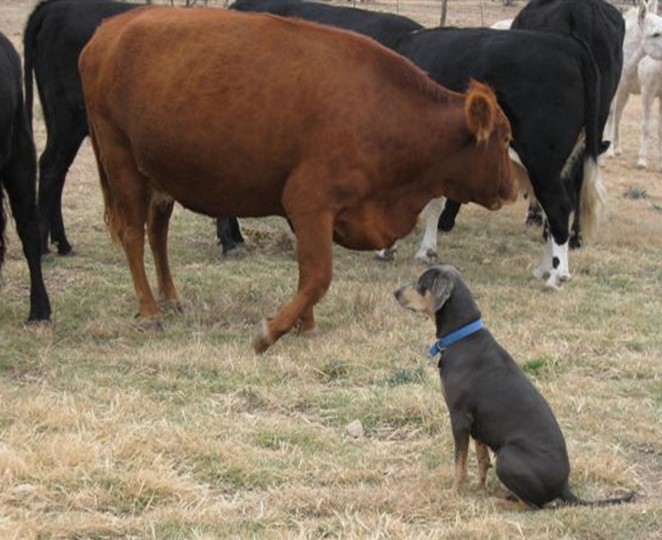
Guard Llama
Llamas are intelligent, instinctively dislike canines, and are capable of protecting livestock from some predator attacks. A tall, alert llama can be intimidating to a predator. Because they are ruminants, llamas can eat the same diet as a flock of sheep or goats they are guarding. They can be expensive to purchase, and in most areas vets have little experience with llamas. A guard llama should always be gelded. It is generally recommended that llamas not be gelded before one year of age because of problems in the growth of leg bones if the male hormones are not available.
Although the snorting and stomping of a llama can be an effective deterrent against a prowling predator, llamas can themselves be vulnerable to packs of predators. Many llama breeders now refuse to sell llamas as livestock guards because their guarding manner — out of natural curiosity, a llama walks toward a marauding predator — can increase their vulnerability. Many sheep farms have had good luck with llamas as guard animals. Some llama breeders use guard dogs for their llamas.
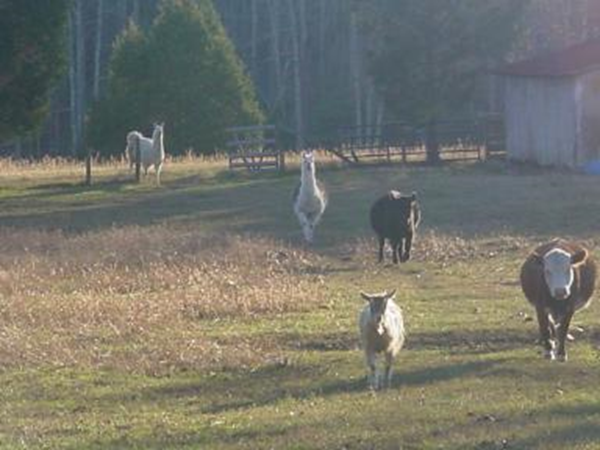
Herding
In parts of Africa, it is usual to see herds of cattle, or flocks of sheep and goats roaming around with nobody watching them. While this is the easy option, it is also the least effective way to ensure the safety of the livestock. Predators are opportunistic and unguarded livestock is an easy meal for them. In East Africa, the Masaai keep someone with the herds of cattle to watch for threats from predators. If spotted, then a predator can usually be scared off.